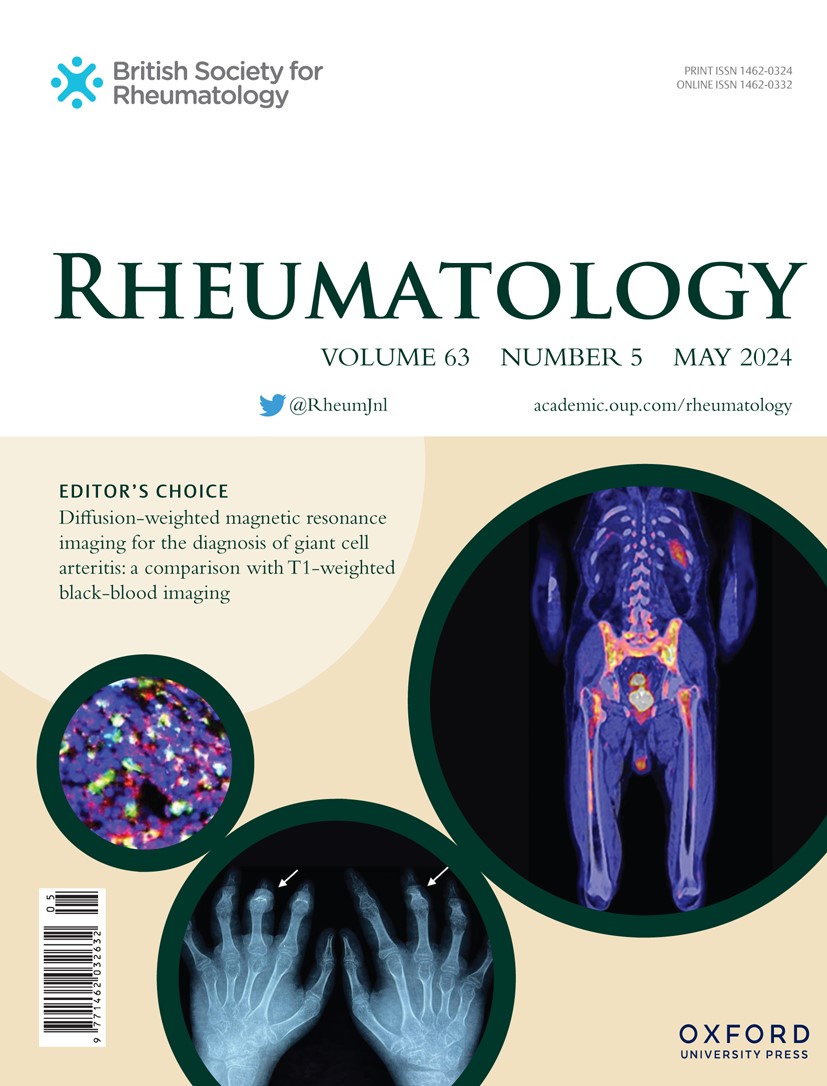银屑病关节炎患者血清蛋白质组学特征的性别差异。
IF 4.7
2区 医学
Q1 RHEUMATOLOGY
引用次数: 0
摘要
目的银屑病关节炎(PsA)患者的临床表现和治疗结果存在性别差异。导致这些差异的生物学途径尚不清楚。我们进行了一项非靶向蛋白质组学研究,以确定男性和女性PsA患者的性别特异性血清蛋白和生物学途径。方法:我们使用适配体为基础的面板测量了50名男性和50名女性活性PsA患者以及50名年龄和性别匹配的非银屑病对照组的6402血清蛋白。差异表达和途径富集分析鉴定了男性和女性PsA患者之间的差异表达蛋白(DEPs)和富集途径。机器学习分类器用于开发性别特异性多生物标志物模型,以区分PsA患者和对照组。随机森林模型突出显示了预测性能最高的蛋白质。结果差异分析显示,PsA男性与对照组(n = 741)的性别特异性dep是PsA女性与对照组(n = 31)的20多倍。PsA男性与PsA女性的dep通路富集与细胞内信号、血管功能、细胞因子信号和免疫细胞功能有关。所有模型都区分了男女PsA与对照,曲线下面积为0.85-0.99。变量重要性分析表明,白三烯a -4水解酶是PsA女性与对照组的重要预测因子,而白细胞介素-36 α、NEK7和PIK3CA/PIK3R1在PsA男性与对照组中具有重要意义。结论PsA患者中男性的异常蛋白和生物学通路明显多于女性。鉴定的蛋白和途径为PsA的性别研究提供了潜在的新靶点。本文章由计算机程序翻译,如有差异,请以英文原文为准。
Sex differences in serum proteomic profiles in psoriatic arthritis.
OBJECTIVES
Sex-related differences exist in the clinical presentation and treatment outcomes of patients with psoriatic arthritis (PsA). The biological pathways driving these differences remain unknown. We conducted an untargeted proteomic study to identify sex-specific serum proteins and biological pathways in males and females with PsA.
METHODS
We used an aptamer-based panel to measure 6402 serum proteins in 50 male and 50 female patients with active PsA and 50 age- and sex-matched non-psoriatic controls. Differential expression and pathway enrichment analysis identified differentially expressed proteins (DEPs) and enriched pathways between male and female PsA patients. Machine learning classifiers were used to develop sex-specific multi-biomarker models to distinguish PsA patients from controls. Proteins with the highest predictive performances were highlighted from random forest models.
RESULTS
The differential analysis revealed over 20 times more sex-specific DEPs in PsA males vs controls (n = 741) than in PsA females vs controls (n = 31). The enriched pathways among DEPs in PsA males vs PsA females were related to intracellular signalling, vascular function, cytokine signalling, and immune cell functions. All models discriminated PsA from controls for both sexes with an area under the curve of 0.85-0.99. Variable importance analysis identified leukotriene A-4 hydrolase as a significant predictor in PsA females vs controls, whereas interleukin-36 alpha, NEK7, and PIK3CA/PIK3R1 were significant in PsA males vs controls.
CONCLUSION
Significantly more dysregulated proteins and biological pathways were found in males than in females with PsA. The identified proteins and pathways offer potential new targets for sex-based research in PsA.
求助全文
通过发布文献求助,成功后即可免费获取论文全文。
去求助
来源期刊

Rheumatology
医学-风湿病学
CiteScore
9.40
自引率
7.30%
发文量
1091
审稿时长
2 months
期刊介绍:
Rheumatology strives to support research and discovery by publishing the highest quality original scientific papers with a focus on basic, clinical and translational research. The journal’s subject areas cover a wide range of paediatric and adult rheumatological conditions from an international perspective. It is an official journal of the British Society for Rheumatology, published by Oxford University Press.
Rheumatology publishes original articles, reviews, editorials, guidelines, concise reports, meta-analyses, original case reports, clinical vignettes, letters and matters arising from published material. The journal takes pride in serving the global rheumatology community, with a focus on high societal impact in the form of podcasts, videos and extended social media presence, and utilizing metrics such as Altmetric. Keep up to date by following the journal on Twitter @RheumJnl.
 求助内容:
求助内容: 应助结果提醒方式:
应助结果提醒方式:


